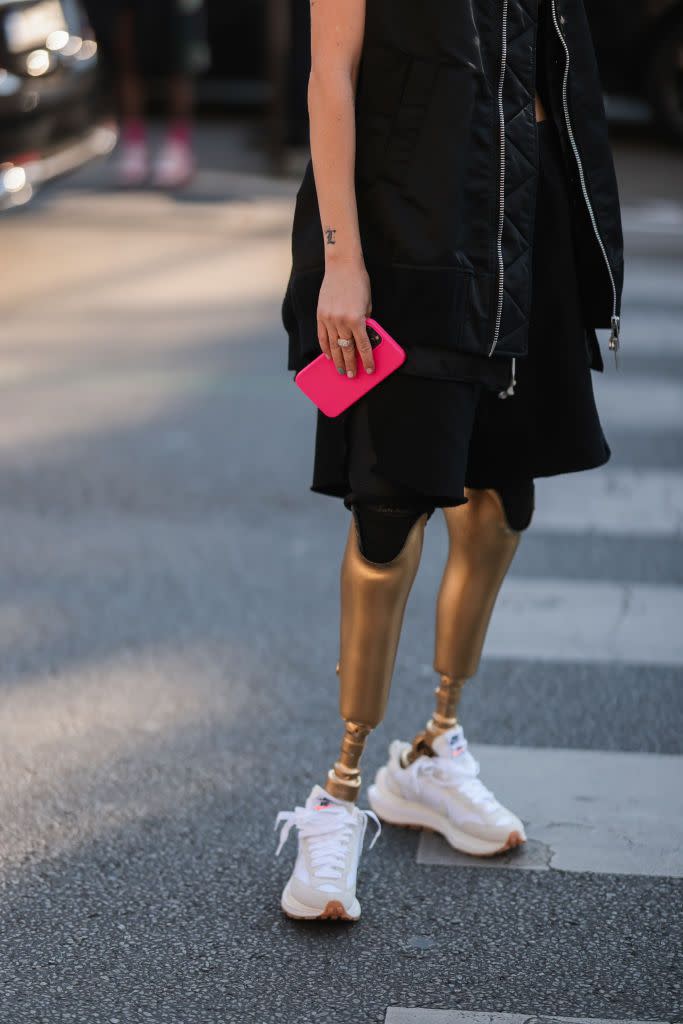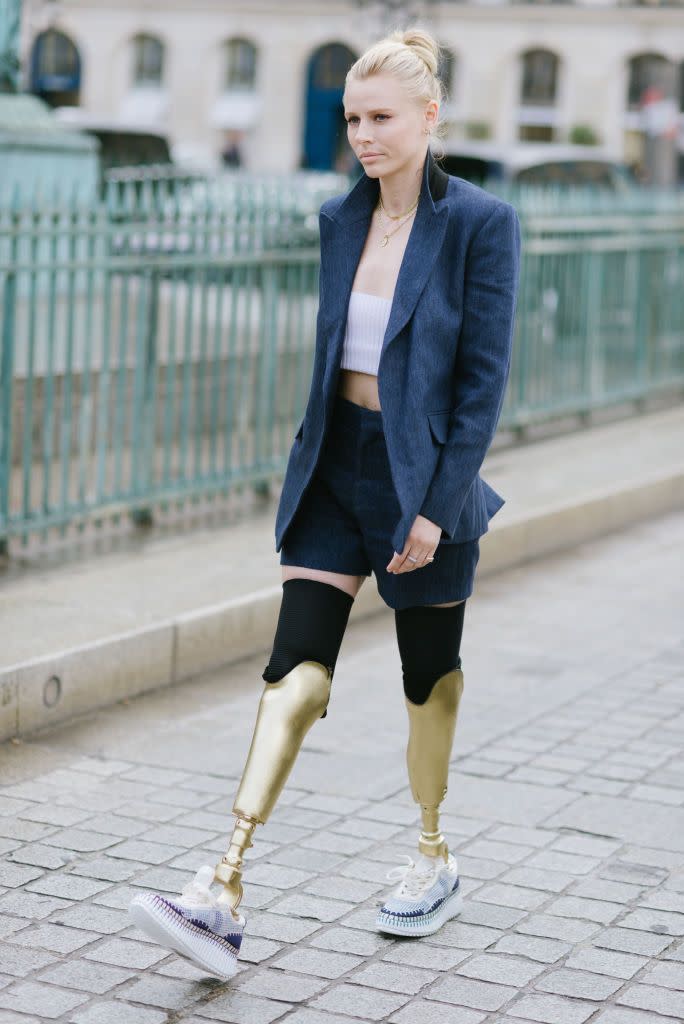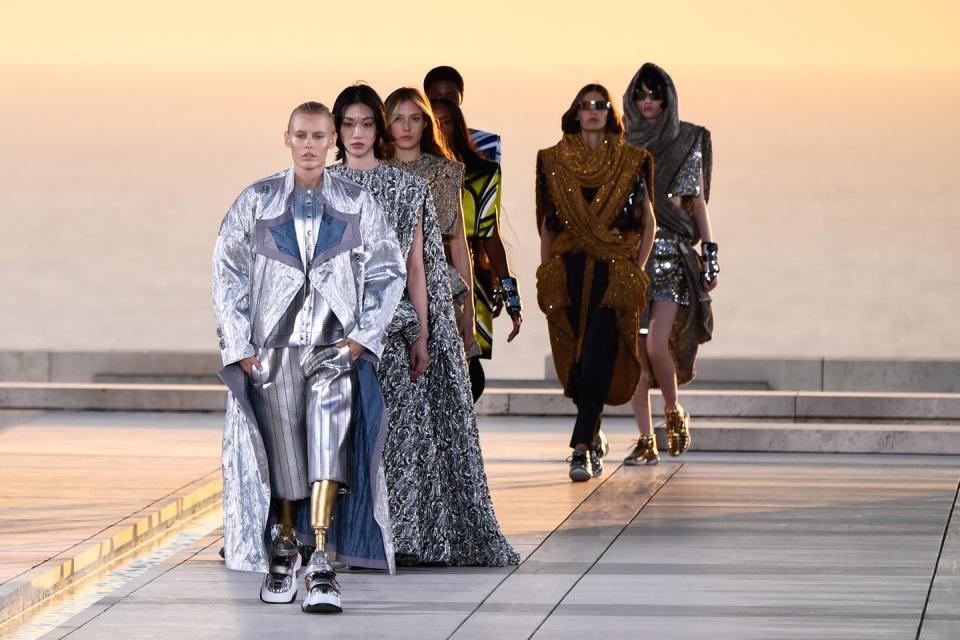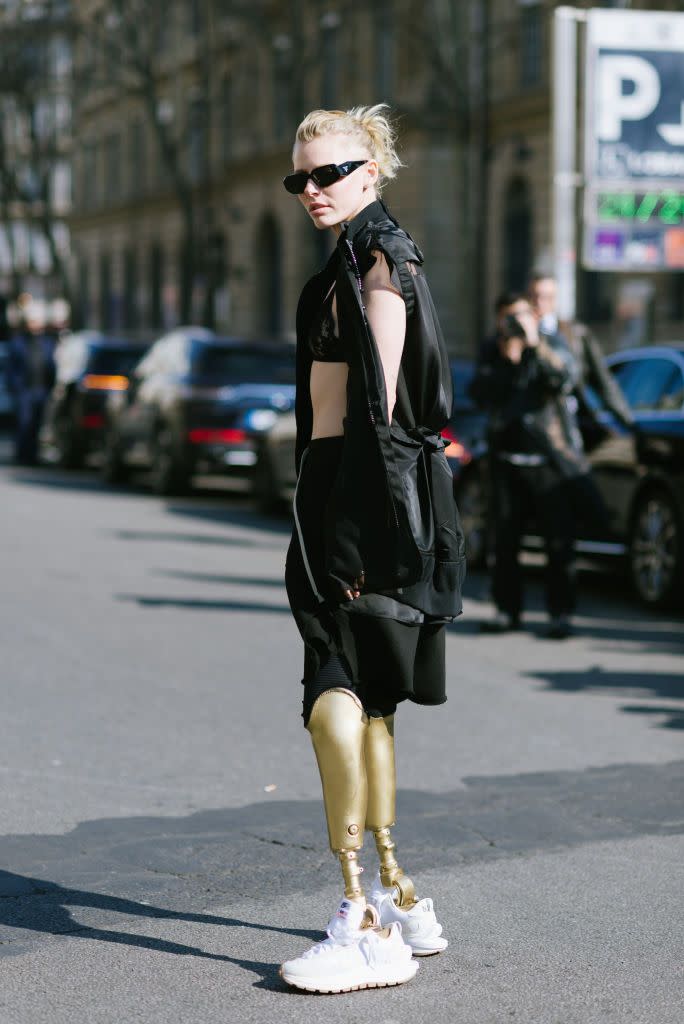Lauren Wasser, fashion’s “Girl with the Golden Legs”, is making history

“I feel like I have a job to do. I want to see women being protected, and I want what happened to me to never happen to another soul again,” says Lauren Wasser from her home in Los Angeles. Ten years ago to this day, the model came down with toxic shock syndrome, which eventually caused her to undergo a double leg amputation – today she is in Paris preparing to walk at the Fashion Week shows. “I could have been in the ground for 10 years now. But here I am, and I feel like I’m on top of the world.”
In 2012, Wasser was an athletic 24-year-old living in Santa Monica, California, the statuesque daughter of two former models who had turned down a full basketball scholarship to a top university for sporting talent to focus on her own rising career in fashion. But life took an unpredictable turn in early October, when she started to feel unwell, as though she were coming down with the flu. She attended a friend’s birthday party but left early; soon after, a concerned friend found her unconscious on her bedroom floor.

She was rushed to the hospital with a high temperature; her internal organs had begun to shut down and she had suffered a heart attack. By the time she was diagnosed with toxic shock syndrome (TSS), she had only a one percent chance of survival. The infection caused her legs to become gangrenous, and she was put into a medically induced coma.
When she woke up, disorientated, the ordeal was far from over. “There was a moment when I was by myself in hospital and everyone who had come to visit me had left my room – my mum, my godfather, everyone,” she remembers, “and I heard the nurse speaking on the phone behind the curtain, saying, ‘I have a 24-year-old girl here who’s going to need a right leg below-the-knee amputation.’ That was the first time I ever heard the word ‘amputation’ in reference to myself. I couldn’t believe it. I didn’t want to believe it. I cried and screamed for my mum to not allow it to happen.” At the time, her doctors had recommended amputating both legs, but there was a 50 per cent chance her left leg could be saved, so she took the risk.
After she was released from hospital, she spent eight months in a wheelchair. “I couldn’t just get up and go to the bathroom, I couldn’t go outside and play basketball, I couldn’t do anything for myself. My whole identity, the person I knew, was completely gone,” she recalls, adding that her belief in God and her loved ones were essential supports throughout. “I’ve come all this way through my faith and through the strength of my family and my friends. My family stood by me when things got rough and really lifted me up. My little brother, who was 13 at the time, is a big reason why I didn’t take my own life. I couldn’t have him find me when he was coming home from school, then live with that burden for the rest of his life. I wanted to show him that no matter what happens, you just have to make the best out of things.”

Gradually, Wasser was able to walk again using a prosthetic leg, but her sense of self was shattered – so friends and family took countless pictures of her to help her come to terms with her new body. “When I saw images or videos that my mum or my friends had taken of me, it was eye-opening because I realised that I do look beautiful, I do look strong. I had been in my own head and standing in my own way, creating this idea of myself that didn’t exist. I thought I couldn’t walk properly, but it was a mindfuck because it wasn’t true.”
While doctors had initially salvaged her left leg, it caused her so much pain in the six years that followed that she had no choice but to have it amputated too, just before she turned 30. “I didn’t have any toes and my heel was so severely damaged, I had to go to the clinic every Monday. I just wasn’t living,” she says. “I’m an athlete, I want to be a mum, and I just wanted to be able to be free and be able to sit down and not have excruciating pain. I made that decision for the rest of my life, to be able to live the life that I know I deserve.”

TSS is a rare but life-threatening condition caused by bacterial infections, typically staphylococcus aureus bacteria. It can be triggered by the use of tampons, though a person must already have the bacteria present in their body to develop it. There has been a surge in TSS-related deaths in women, since the composition of most sanitary products changed from natural fibres to synthetic, providing bacteria with an environment to thrive in. Studies now suggest TSS affects three women of reproductive age out of 100,000 every year.
In the decade since she was infected, Wasser has refocused her life’s work to advocate for education on tampons, changing the collective conversation around TSS. “It’s sad that people only know my story, because there are thousands of women who have died or have been affected by this that no one will ever know about. This can happen to anyone at any time, no one is off limits.” She has also been working with the US Democratic congresswoman Carolyn Maloney to promote legislation requiring manufacturers to list all ingredients of feminine-hygiene items on their packaging. “These products are not safe, but they are all we know because they’re the only ones that have been on the market. They’re made using chlorine bleach, dioxin and synthetic fibres, which create the perfect storm in our bodies,” she explains. “It’s a billion-dollar industry, so it’s a money issue, and it’s men who are making the decisions for us. That’s why I fight so hard, because we should be protected.”

Wasser has also been making her mark in the fashion industry, starring in campaigns for Lacoste, Furla and Shiseido, and acquiring the nickname of fashion’s “Girl with the Golden Legs”. Last month, she walked in Gabriela Hearst’s S/S 23 show at New York fashion week and earlier this year she appeared on the catwalk resplendent in silver for Louis Vuitton’s Cruise 2023 presentation. “For me and my team, the show was such an iconic moment because I’ve worked so hard to be myself, never take ‘no’ for an answer and never be put in whatever type of box society or the industry tries to put me in,” she says. “For Nicolas [Ghesquière] and for Louis Vuitton to put me on such a platform was that ‘we did it’ moment. I mean, you’ve never seen someone like myself highlighted by such a powerful fashion house. It was history in the making.”
Indeed, by strutting down the runway in her golden prosthetic legs, Wasser is bringing an unprecedented level of visibility for differently abled people to the industry – a responsibility she doesn’t take lightly. “If there’s a little girl who’s losing her leg and sees me up there, that could be a dream of hers. Or if someone is going through a difficult time, in whatever capacity, maybe they can look me up and know that I got through some really heavy things – and if I can do it, they can too.
“We’re really breaking down stereotypes and it’s exciting because it’s allowing people to be seen in a space that they haven’t been in before. I wouldn’t have thought that I would be in my position 20 or even 10 years ago. I was sitting in my room contemplating suicide, because I never thought in a million years I would be accepted by society, let alone the fashion industry.

“Perfection doesn’t exist. I get so upset about apps like Facetune because girls are growing up with a false image of what beauty is. They should love and appreciate who they are because that’s why they’re special. Diversity is what makes the world so cool and beautiful.”
Early next year, Wasser plans to take part in the Los Angeles Marathon using running blades – “to be able to put those on, go outside and be free to feel the wind and the movement of my hair bouncing is priceless” – and she is also working on a documentary of her own life. “I can tell you my story all day long, but if you visually see me in that state, it hits home. I recently watched it and I can only look at myself and feel so bad because I was so innocent. I had no idea what had happened and how it happened – and it was irreversible. It’s wild that a tampon almost killed me.
“The more I speak, the more I am seen, the more change will hopefully come. I don’t think it’s going to happen soon; it’s going to take some time – it may even take my whole entire lifetime – but my goal is to leave this world better than I found it.”

You Might Also Like

 Yahoo Movies
Yahoo Movies 